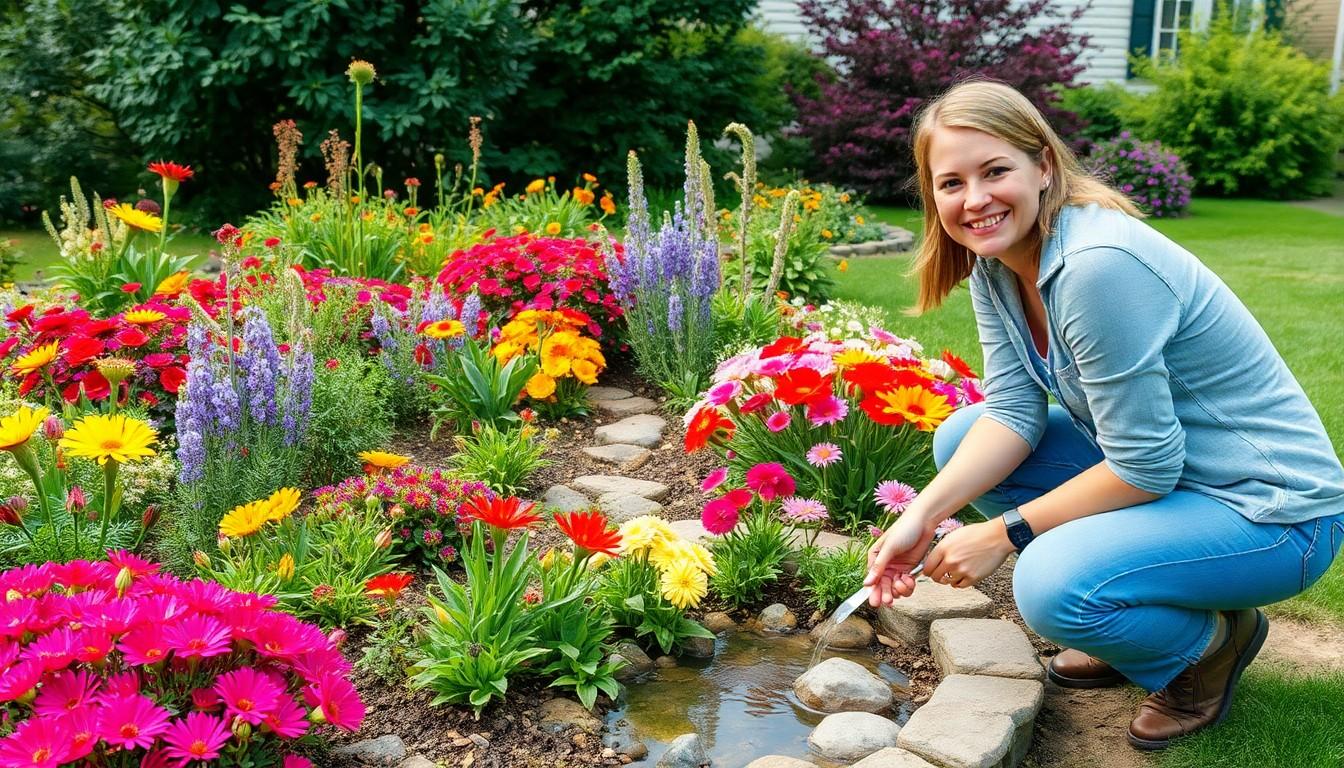In a world where lawns can be greener than envy, eco-friendly landscaping is the hero we didn’t know we needed. Picture this: instead of using harsh chemicals that could wake the neighbors’ pet goldfish, imagine transforming your yard into a lush paradise that even Mother Nature would high-five you for. It’s not just about looking good; it’s about doing good too.
Eco-Friendly Landscaping
Eco-friendly landscaping focuses on sustainable practices that promote environmental health. It reduces reliance on harmful chemicals, fostering a safer habitat for wildlife and humans. Incorporating native plants enhances biodiversity and requires less water, making maintenance easier.
Designing spaces with permeable materials helps manage stormwater runoff. Raised beds and vertical gardens improve soil quality and utilize smaller areas effectively. These techniques not only create aesthetic appeal but also promote responsible resource use.
Sustainable landscaping emphasizes organic fertilizers and pest control methods. Techniques such as companion planting attract beneficial insects, reducing the need for chemical pesticides. This approach encourages a balanced ecosystem within outdoor spaces.
Incorporating rain gardens captures runoff, filtering pollutants and allowing water to recharge the groundwater supply. Planting trees contributes to shade, reducing energy costs for cooling in warmer months. A thoughtful selection of flora can create resilient landscapes that thrive in local climates.
Using mulch minimizes weeds while retaining soil moisture. Promoting composting practices reduces waste and enriches soil with nutrients, further enhancing plant growth. These eco-friendly strategies create healthier environments, benefiting both gardens and surrounding ecosystems.
Choosing local resources and sustainable materials minimizes carbon footprints during landscaping projects. Educating homeowners about eco-conscious choices fosters a community dedicated to preserving nature. Every effort in eco-friendly landscaping leads towards a greener future connected with the environment.
Benefits of Eco-Friendly Landscaping

Eco-friendly landscaping offers numerous benefits that extend beyond aesthetics. It promotes environmental health while providing practical advantages.
Environmental Impact
Adopting eco-friendly landscaping practices significantly reduces environmental degradation. Native plants require less water and maintenance, supporting local wildlife. Chemical pesticides and fertilizers can harm ecosystems; organic alternatives prevent this damage. Rain gardens enhance stormwater management, reducing runoff and filtering pollutants. Sustainable materials limit carbon footprints and conserve resources. Communities benefit from increased biodiversity, improved air quality, and enhanced urban green spaces. Eco-friendly techniques foster resilience against climate change, contributing to a healthier planet.
Cost Savings
Implementing eco-friendly landscaping results in substantial cost savings. Reducing water usage directly lowers utility bills; drought-resistant plants minimize irrigation needs. Organic fertilizers and pest control methods protect investments while improving soil health. Long-lasting materials reduce replacement costs over time. Energy-efficient trees provide shade, decreasing air conditioning expenses. Composting practices recycle yard waste, eliminating disposal fees. By investing in sustainable landscaping, homeowners realize financial benefits alongside environmental gains.
Key Principles of Eco-Friendly Landscaping
Eco-friendly landscaping incorporates sustainable methods that promote environmental health. It emphasizes practices that reduce resource consumption and enhance local ecosystems.
Native Plant Selection
Choosing native plants fosters biodiversity and reduces maintenance needs. Local plants adapt well to the region, requiring less water and minimal fertilizer. Some plants attract beneficial insects, leading to natural pest control. Well-adapted species thrive in native soils and climates, so they contribute to a healthier environment. Selecting diverse species creates a resilient landscape that supports various wildlife. Homeowners often appreciate the aesthetic value these plants add, creating vibrant outdoor spaces that reflect local character.
Water Conservation Techniques
Implementing water conservation techniques optimizes water use in landscaping. Rain barrels collect and store runoff for irrigation, maximizing natural resources. Permeable paving allows water to infiltrate, reducing runoff and replenishing groundwater. Incorporating drip irrigation systems ensures plants receive targeted moisture, minimizing waste. Drought-resistant plants lower the overall need for watering. Mulching retains soil moisture, preventing evaporation and regulating temperature. Adopting these methods significantly decreases water bills while promoting sustainable outdoor spaces.
Sustainable Practices in Eco-Friendly Landscaping
Sustainable practices in eco-friendly landscaping support environmental health while enhancing outdoor aesthetics. These methods include a commitment to organic gardening and recycling materials.
Organic Gardening Methods
Organic gardening methods rely on natural processes to maintain healthy ecosystems. These methods involve using organic fertilizers like compost, which enriches soil and promotes plant growth. Natural pest control uses beneficial insects, such as ladybugs, to manage harmful pests without chemicals. Cover cropping improves soil quality by preventing erosion and enhancing nutrient availability. Crop rotation diversifies plant species and reduces disease and pest buildup in gardens. By implementing these techniques, gardeners avoid synthetic chemicals, creating a healthier environment.
Use of Recycled Materials
Using recycled materials in landscaping significantly reduces waste and minimizes environmental impact. Reclaimed wood often serves as garden borders or raised bed frames, promoting sustainable practices. Local stone can create pathways or decorative features while reducing transportation emissions. Recycled concrete offers durable options for patios and walkways, enhancing outdoor spaces. Additionally, repurposed materials like glass and metal can form artistic elements to enrich landscaping designs. By prioritizing recycled materials, individuals contribute to a circular economy while beautifying their surroundings.
Challenges in Implementing Eco-Friendly Landscaping
Implementing eco-friendly landscaping poses several challenges that can impede progress. Initial costs for sustainable materials and practices can be higher than traditional options, discouraging many homeowners. Limited knowledge about sustainable techniques often leads to uncertainty, making it difficult for individuals to get started.
Time constraints present another barrier, as eco-friendly methods frequently require more planning and maintenance. Educating the community about the benefits of these practices is essential to foster a supportive environment. Individuals may face resistance from neighbors who prefer conventional landscaping, creating a divide between aesthetic choices and sustainable options.
Finding local native plants can be problematic in some areas, limiting the ability to create a biodiverse landscape. Water conservation efforts, while crucial, may require ongoing monitoring and adjustments that can add to the workload. Additionally, although organic fertilizers and pest control methods promote healthier ecosystems, they may not deliver immediate results, leading to skepticism among property owners.
Regulatory challenges can also arise, with strict zoning or code requirements affecting the design and implementation of eco-friendly features. Local regulations might not support the inclusion of rain gardens or permeable paving, hindering the potential for effective stormwater management.
Lastly, ongoing maintenance of sustainable landscapes can present difficulties due to seasonal changes, making it hard to keep plants healthy and thriving. Addressing these challenges effectively involves a combination of education, community support, and persistence in adopting eco-friendly landscaping practices.
Promote Healthier Ecosystems
Embracing eco-friendly landscaping is a powerful step toward a sustainable future. By prioritizing native plants and organic practices, individuals can create vibrant outdoor spaces that benefit both the environment and their communities. The advantages extend beyond aesthetics, offering financial savings and improved biodiversity.
While challenges exist, the commitment to eco-friendly methods fosters resilience against climate change and promotes healthier ecosystems. By investing time and resources into sustainable landscaping, homeowners not only enhance their properties but also contribute to a greener planet. Every small change makes a difference, and together, these efforts can lead to significant environmental improvements.

